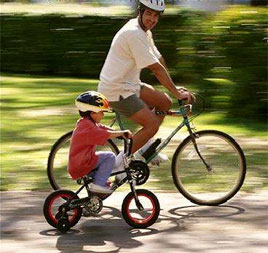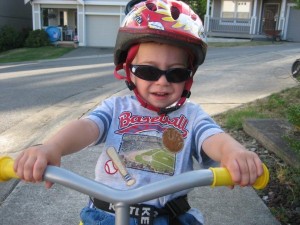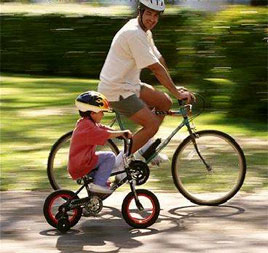Before using your bicycle, make sure it is ready to ride. You should always inspect your bike to make sure all parts are secure and working properly.
Remember to:
- Wear a Properly Fitted Bicycle Helmet. Protect your brain, save your life.
- Adjust Your Bicycle to Fit. Stand over your bicycle. There should be 1 to 2 inches between you and the top tube (bar) if using a road bike and 3 to 4 inches if a mountain bicycle. The seat should be level front to back. The seat height should be adjusted to allow a slight bend at the knee when the leg is fully extended. The handlebar height should be at the same level with the seat.
- Check Your Equipment. Before riding, inflate tires properly and check that your brakes work.
- See and Be Seen. Whether daytime, dawn, dusk, foul weather, or at night, you need to be seen by others. Wearing white has not been shown to make you more visible. Rather, always wear neon, fluorescent, or other bright colors when riding day or night. Also wear something that reflects light, such as reflective tape or markings, or flashing lights. Remember, just because you can see a driver doesn’t mean the driver can see you.
- Control Your Bicycle. Always ride with at least one hand on the handlebars. Carry books and other items in a bicycle carrier or backpack.
- Watch for and Avoid Road Hazards. Be on the lookout for hazards such as potholes, broken glass, gravel, puddles, leaves, and dogs. All these hazards can cause a crash. If you are riding with friends and you are in the lead, yell out and point to the hazard to alert the riders behind you.
- Avoid Riding at Night. It is far more dangerous to ride at night than during the day because you are harder for others to see. If you have to ride at night, wear something that makes you more easily seen by others. Make sure you have reflectors on the front and rear of your bicycle (white lights on the front and red rear reflectors are required by law in many States), in addition to reflectors on your tires, so others can see you.
Many bicycle-related crashes resulting in injury or death are associated with the bicyclist’s behavior, including such things as not wearing a bicycle helmet, riding into a street without stopping, turning left or swerving into traffic that is coming from behind, running a stop sign, and riding the wrong way in traffic. To maximize your safety, always wear a helmet AND follow the rules of the road.



